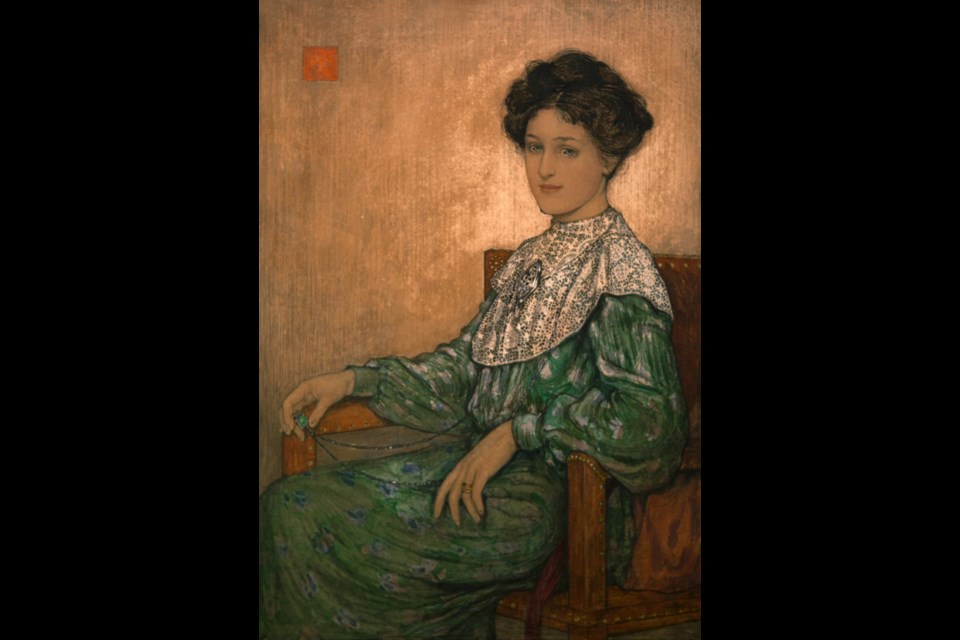 In my imagination, Katharine Maltwood sits in a 16th-century English oak chair, looking out over Victoria from her home at Royal Oak. It’s about 1945, yet the house named the Thatch is, to all appearances, an English country manor. Across the great hall, her sculptures in Portland stone and alabaster stand, set off with tapestries as if they were idols in their own shrines.
In my imagination, Katharine Maltwood sits in a 16th-century English oak chair, looking out over Victoria from her home at Royal Oak. It’s about 1945, yet the house named the Thatch is, to all appearances, an English country manor. Across the great hall, her sculptures in Portland stone and alabaster stand, set off with tapestries as if they were idols in their own shrines.
The room is plastered white, with dark oak beams, antique Persian carpets and scrolls from 13th-century Japan. On the mantelpiece are Buddhist statues and Chinese vessels of bronze and jade. The whole is arranged not just to show off the souvenirs of years of travel, but to instruct, to elevate and inspire.
Maltwood created most of these carvings when she was a free-thinking young woman in London, in the first years of the 20th century. It was the time when William Morris inspired some to rise above the industrial age and regain the essence of craftsmanship, the delight in making things by hand to enhance the domestic environment. Have nothing that is not beautiful, he preached, and Maltwood took him at his word.
She created low-relief carvings to embellish baptismal fonts and fountains. Her work was exhibited at the Royal Academy, and by the more advanced Grosvenor Gallery in London. Her masterpiece was a sculpture for Alice and Elbert Hubbard, whose Roycrofters village in upstate New York was the centrepiece of the American Arts and Crafts movement. Titled Magna Mater, it was literally the focal point of the community.
John Maltwood, her husband and soulmate, gave her every encouragement. As the managing director of the Oxo corporation, he had the means. They visited France and Italy, and upon his early retirement, the childless couple pursued their spiritual quest with leisurely tours to Egypt, the Middle East, the South Pacific, China and Japan.
They sought a cosmic synthesis like Madame Blavatsky’s Theosophy, finding commonality in all ancient religions. Among the Maltwoods’ many acquaintances in England was D.T. Suzuki, who brought Zen Buddhism to the West.
The Maltwoods lived in Chilton Priory, Somerset, a faux-gothic castle, where Katharine had her study at the top of the tower. It looked out over Glastonbury Tor in southern England, a conical landform. Glastonbury was at the heart of the Arthurian legends, and an inspiration of the Arts and Crafts people.
It was said that Joseph of Arimathea had brought the Holy Grail, the communion vessel of the Last Supper, to this place soon after the crucifixion. The quest of the Knights of the Round Table could be understood with reference to these improbable concepts. Katharine believed that, for about 15 kilometres around Glastonbury, there were ancient earthworks that could be read as a zodiac.
Back in Victoria, Katharine sat with a globe beside her chair, painted as the sky and overlaid with cut-out astrological symbols. On the wall above the fireplace hung a huge carved wooden zodiac. The Maltwoods had left England just before the Second World War, sensing that the English would never understand her philosophical syncretism. Canada was the pure, strong new land, and she embraced it with great satisfaction.
People here who seemed sympathetic came to visit the Thatch. The Maltwoods patronized the best local artists: Emily Carr, Charles John Collings and Peggy Walton Packard. And they attracted art-active citizens, too.
Hildegard Wyllies’ family had been involved in artistic circles in England for generations, with connections to William Blake, Samuel Palmer and John Ruskin. Ina Uhthoff was Victoria’s leading art teacher and had her education at the Glasgow School of Art, famous for the Arts and Crafts ethic and the teaching of Charles Rennie Macintosh. These three women believed that Victoria needed a civic art gallery and did their best to make it a reality.
Uhthoff and Wyllie eventually brought the Art Gallery of Victoria into existence in 1951. For their part, the Maltwoods left Katharine’s art works and all their treasures, numbering many thousands of pieces, to the University of Victoria. She died in 1961, and with the Maltwood collection came the Thatch, the obvious place to house this focused group of artifacts, and an endowment to the university. For its part, the university petitioned to alter the trust, and in 1977 moved everything to the new Maltwood Museum and Art Gallery at the university.
Three years ago, citing need for more cafeteria space, the university closed that gallery, and for now the Maltwood name is attached to a prints and drawings room in the basement of the library. The Maltwood gift has been somewhat overwhelmed by the more recent gift, by Michael Williams, of art and real estate. The Legacy Gallery downtown, in a building he gave to the university, is now the centre of the University Art Collections.
But the Maltwood gift is not forgotten. Maltwood’s voluminous papers were recently digitized by a researcher from the University of Washington (uvic.ca/library/ featured/collections/k-e-maltwood/ index.php) — and for the moment her artistry and ideals are being celebrated in the smaller gallery at the Legacy, lovingly curated by Caroline Riedel. It takes its place at the centre of a larger exhibit, Beauty for All, dedicated to the Arts and Crafts movement, which founding curator Martin Segger had for many years taken as the theme of the university’s collection.
If this piques your interest, the 1981 book Katharine Emma Maltwood (1878-1961) by Rosemary Brown will fill in many fascinating gaps. The exhibition is a great way to discover Katharine Maltwood, a major player in our art history.



